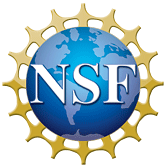Property:Extended model description
From CSDMS
This is a property of type Text.
L
This module code is inactive. +
C
This module code is inactive. +
F
This module code is inactive. +
This module code is inactive. +
1
This module implements a particle-based model of hillslope evolution, which has an associated continuum description (introduced here: https://arxiv.org/abs/1801.02810). The model takes as input a few simple parameters which determine the equilibrium hillslope shape and dynamics, and can be used to produce equilibrium profiles and study the response of the hillslope to perturbations. The model benefits from straightforward implementation, as well as the flexibility to incorporate sophisticated perturbations and to be accessorized by local or nonlocal fluxes. +
S
This module implements sediment flux dependent channel incision following::
E = f(Qs, Qc) * ((a stream power-like term) - (an optional threshold)),
where E is the bed erosion rate, Qs is the volumetric sediment flux into a node, and Qc is the volumetric sediment transport capacity at that node.
This component is under active research and development; proceed with its use at your own risk. +
P
This module uses Taylor Perron’s implicit (2011) method to solve the nonlinear hillslope diffusion equation across a rectangular, regular grid for a single timestep. Note it works with the mass flux implicitly, and thus does not actually calculate it. Grid must be at least 5x5.
Boundary condition handling assumes each edge uses the same BC for each of its nodes. This component cannot yet handle looped boundary conditions, but all others should be fine.
This component has KNOWN STABILITY ISSUES which will be resolved in a future release; use at your own risk. +
E
This numerical 1D research code Elv applied to gravel-sand transitions relates to Blom et al., 2017 "Advance, retreat, and halt of abrupt gravel-sand transitions in alluvial rivers", http://dx.doi.org/10.1002/2017GL074231. +
Z
This object manages ‘zones’ that are used to evaluate the spatial aspect of taxa. A zone represents a portion of a model grid. It is made up of spatially continuous grid nodes. +
T
This process component is part of a spatially-distributed hydrologic model called TopoFlow, but it can now be used as a stand-alone model. It uses the "diffusive wave" method to compute flow velocities for all of the channels in a D8-based river network. This method includes a pressure gradient term that is induced by a water-depth gradient in the downstream direction. This means that instead of using bed slope in Manning's equation or the law of the wall, the water-surface slope is used. +
This process component is part of a spatially-distributed hydrologic model called TopoFlow, but it can now be used as a stand-alone model. The kinematic wave method (Lighthill and Whitham, 1955) is the simplest method for modeling flow in open channels. This method combines mass conservation with the simplest possible treatment of momentum conservation, namely that all terms in the general momentum equation (pressure gradient, local acceleration and convective acceleration) are neglible except the friction and gravity terms. A flow in which gravitational acceleration is exactly balanced by friction is referred to as steady, uniform flow. For these flows the water surface slope, energy slope and bed slope are all equal. +
This process component is part of a spatially-distributed hydrologic model called TopoFlow, but it can now be used as a stand-alone model. TopoFlow supports three different types of flow diversions: sources, sinks and canals. Sources are locations such as natural springs where water enters the watershed at a point by some process other than those that are otherwise modeled. Similarly, sinks are locations where water leaves the watershed at a point. Canals are generally man-made reaches such as tunnels or irrigation ditches that transport water from one point to another, typically without following the natural gradient of the terrain that is indicated by the DEM. The upstream end is essentially a sink and the downstream end a source. +
This process component is part of a spatially-distributed hydrologic model called TopoFlow, but it can now be used as a stand-alone model. The dynamic wave method is the most complete and complex method for modeling flow in open channels. This method retains all of the terms in the full, 1D momentum equation, including the gravity, friction and pressure gradient terms (as used by the diffusive wave method) as well as local and convective acceleration (or momentum flux) terms. This full equation is known as the St. Venant equation. In the current version of TopoFlow it is assumed that the flow directions are static and given by a D8 flow grid. In this case, integral vs. differential forms of the conservation equations for mass and momentum can be used. +
This process component is part of a spatially-distributed hydrologic model called TopoFlow, but it can now be used as a stand-alone model. +
This process component is part of a spatially-distributed hydrologic model called TopoFlow, but it can now be used as a stand-alone model. +
This process component is part of a spatially-distributed hydrologic model called TopoFlow, but it can now be used as a stand-alone model. +
This process component is part of a spatially-distributed hydrologic model called TopoFlow, but it can now be used as a stand-alone model. +
This process component is part of a spatially-distributed hydrologic model called TopoFlow, but it can now be used as a stand-alone model. +
This process component is part of a spatially-distributed hydrologic model called TopoFlow, but it can now be used as a stand-alone model. +
This process component is part of a spatially-distributed hydrologic model called TopoFlow, but it can now be used as a stand-alone model. +
